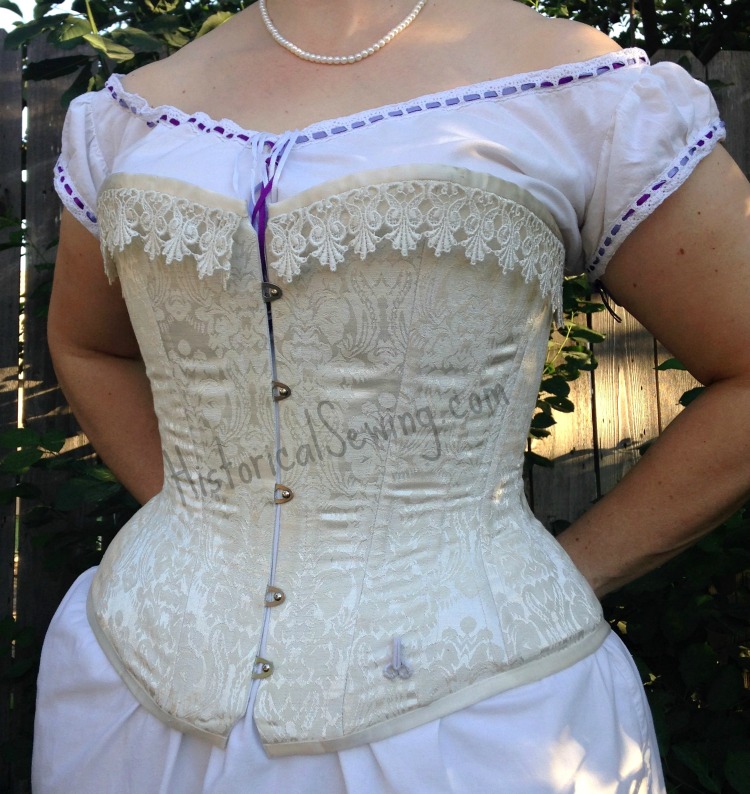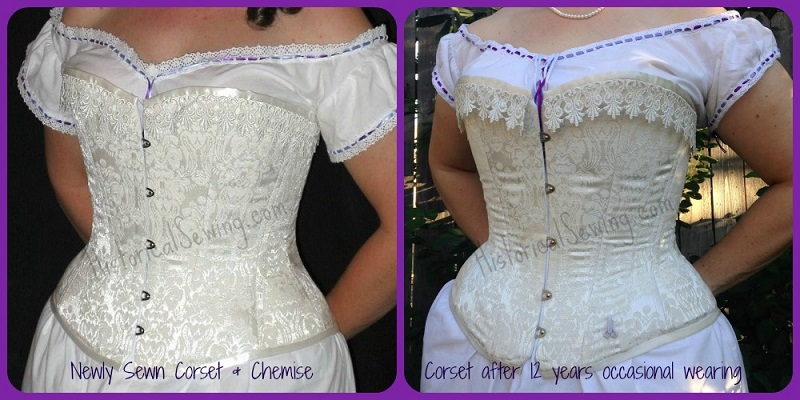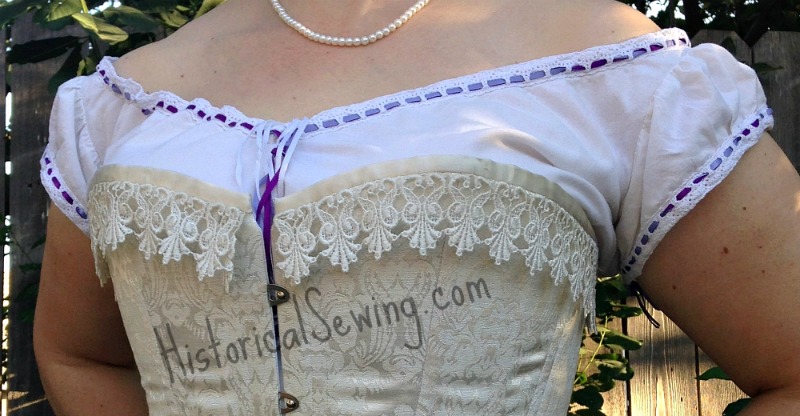
While fitting my latest mockup (an 1838 single dart bodice with back closing), I realized I was choosing to wear my rather old corset made in 2002. This isn’t a bad thing as I love this particular corset – it gives a great shape and is fitted relatively well.
My beloved cream cotton brocade undergarment is my tried & true friend. It’s been worn for over a decade, time traveled thru nearly every decade in the 19th Century including quite dusty Civil War venues, and been worn in three U.S. states. This thing has history!
And this is what it looks like today…

Not too bad considering!
The poly satin ribbon binding is much stained around the top from sweating – and probably rubbing on colored underlining fabrics. Although, the high-quality coutil and brocade don’t show much staining at all. Simply a little dirty.
And it doesn’t smell because I’ve used the cheap Vodka trick (#16 in this post) over the years. – Spray bottom shelf Vodka (full strength or diluted) on sweat-stained areas to help eat away at the odor-causing bacteria. This doesn’t clean the fabric (of course, as indicated by my still-soiled corset) but does eliminate the odor.
The laces are still good and intact after thousands of cinchings. The busk – well… It pops open at the bottom as I’m first getting into it. But all the metal bones are in place and working well!

You can also see how much the entire corset has formed to my particular figure over time. It’s especially visible at the waistline on the sides. The bones have curved with my figure a bit, sit well and make for a very comfortable corset.
A note for those thinking of using plastic to bone a corset: it doesn’t work. The plastic material will deform from heat released by your body. It’s fine for the first wearing or two but that plastic will soon get horribly uncomfortable. Notice that my corset here has all metal boning. Even though the fabric has stretched & formed over my curves, the bones are still holding it in place. No warping. Think on this before deciding on plastic bones.
Update, Summer 2016: Apparently the synthetic (plastic) whalebone is getting strong attention nowadays. I have not used it but there are some well-known costumers who have and are getting great results. Until I’ve experienced working with it in projects and wearing those garments I will remain loyal to metal boning. Let me know if you like the plastic stuff.
I can’t really remember what pattern I used for this corset. It may have been my own custom pattern I drafted in fashion school.
The chemise is the old version of the Truly Victorian #102 Chemise & Drawers pattern. Heather changed it to have a shoulder opening and the sleeves are different as a result. For the one here I ended up taking large pleats/tucks at the hem line to bring the sleeve closer into my arm. This makes it easier to push the sleeve down into a tight bodice armhole.

The other “damage” to the chemise is the ripping right at the center front V. It’s simply the cut of the fabric that makes this point weak. I have reinforced it a couple times but it’s starting to rip further. Time for another chemise too…. (Fortunately, I made a new one in the Victorian Undergarments Class.)
You can also see how the cotton lace edging has shrunk over dozens of washings. I wash my chemise & drawers in warm and tumble dry. I suppose I could press the trim out but it won’t ever look as it did when newly made.
I’ve been saying for years that I need to make a new one from the same pattern and simply make some small alterations. Just so I have a new corset in this fit. I’ll get to it. Add it to the project list. For now, these trusty undergarments fit the bill.
How are your undergarments and old corsets holding up after years of wear?

About the plastic bones– I can’t compare their performance or feel to steel, as I’ve only made one corset so far. I found two kinds of “German plastic” bones; I chose the thicker, striped variety which is apparently different from the “synth whalebone”. The stripes are because it has two different plastics: the white streaks are super hard and tough, the clear surround is soft enough to dent with my nail. I decided against steel because I wanted to cut the bones myself but did not want to mess with metal. These plastic bones I just cut with craft scissors and rubbed the ends smooth on fine sand paper, no special tools and no dipping or sparks or flying metal filings! I was especially glad I could alter the bones myself when I decided to take two inches off the bottom so I could wear pants under it. If I had ordered pre-cut metal bones that would not have been an option.
Plastic bones are lightweight, will not rust, and will not set off airport scanners (you would need to skip the busk and use thread eyelets instead of metal of course). Also, if you accidentally hit one with your sewing machine needle, the needle probably won’t break, you’ll just have a thread running through your bone (I did this accidentally when putting on the binding).
The finished corset is a single-layer underbust with a high back and 14 bones (7mm width), and a 6 inch reduction from my 42 inch waist is comfortable to wear for half a day. The plastic bones definitely keep it in shape, needed only a couple hours to break in, and have not kinked or pinched– and I have done house chores, been in and out of cars, and toted toddlers while wearing it.
The bone can twist, and it can flex toward either flat side, but it can’t flex toward its edges, so the bones can dig into you on one edge if you put them into too complex a curve, just like a flat steel would. However, there are different widths of the plastic boning, so maybe one is narrow enough that it can flex more like a spiral steel. Also, these plastic bones look very thick compared to most flat steels, but are smoother-looking than spirals when under one layer of fabric.
I think that about covers all I know that might be relevant!
My Victorian corset is going on about 10 years and still looking pretty much new except for around the busk in the front which has some snagging. I found it helps very much to have a corset cover which prevents fabric wear and soiling…and make it machine washable!
I am still using my first pair of bloomers and petticoat…both made in 1984! I don’t wear them all of the time of course, otherwise they wouldn’t have lasted this long. It was period to put in patches over weak or torn areas. When this happens I add matching patches in corresponding areas to make it look like it was done on purpose. 🙂
Hi Jen! I’m in the middle of making a mid 19th century corset; what is a good realistic expectation of eras I can cover just with the one corset? I’m talking mostly in terms of shape, not really in specific era techniques.
A good Victorian hourglass shaping corset will do you well from 1830s to 1900 with only needing petticoats and other silhouette supporting garments.
My favorite corset is my Renaissance era Pair of Bodies corded corset made in 2002. I have one made from the same pattern that has steel bones and I use it for court dresses, but for everything else that old beauty is my go-to. It breathes, moves, washes and can be sewn over.
I used cotton duck (coutil hadn’t been invented yet in 1526) and hemp twine for the cording. A wire hanger bent into a huge-eyed needle pulled the doubled cord through the many boning channels. Since I am VERY large busted I did use some metal bones where extra support was needed.
Now, 12 years later the color has faded into a light tan/gray and one eyelet needs re-doing, but it’s as good as ever to wear. Its steel-boned sister, now 10 years old, is holding up just as well.
My favourite corset is also my oldest – sixteen years old, and still cinching beautifully. It’s so perfectly molded to my body that it’s my first choice if I know I’m going to be laced in for a long period of time, or if I want to lace up tighter than usual. Since it’s black, it doesn’t show any discolouration, and I’ve used the vodka trick to keep it smelling fresh, too. The ribbon I originally laced it with has stretched, but is still holding strong. The only serious sign of age and use it’s showing is some wear along the busk, lacing, and bone casings, where the original black satin is wearing through. I know that means I’ll probably have to retire it soon, but I’m reluctant to give up its cozy, perfect fit. When it finally becomes unwearable, I plan to disassemble it, and use it as the pattern for my next corset. Maybe I can even salvage the busk and bones for a perfect worn-in fit!
In the second picture, what is that hook for? I’ve seen it on extant corsets before.
My Laughing Moon Victorian Underwear pattern set just arrived yesterday, and in the historical information supplement there was a period drawing of a corset with a similar hook on the front. The description said that the hook was used to secure the extra lacing, so it didn’t just hang down the wearer’s back when cinched and tied. Very clever!
You’ll find a few uses for that front hook. I think primarily the hook was to keep the petticoats down away from the waistline by simply tucking their top edge under the hook then fastening the closure at the back (mainly drawstring). There could also be a loop on the inside of the skirt waistband to loop around the corset hook so the skirts wouldn’t shift on you (prone to happen – speaking from experience here).
Lastly, as K mentioned, for corset laces. I do this with mine and have for years. It gives you a nice way to tie off the corset yourself and also easy access if you need to loosen the laces during wearing. Although it does create a lump of the knot at the front, so it’s not recommended for form fitting skirts like the Natural Form Era dresses. I thought the hook was mainly for tying laces in the front but have since learned that’s not completely accurate. I do believe it’s to keep the petticoats down from the waist and in place to avoid shifting.